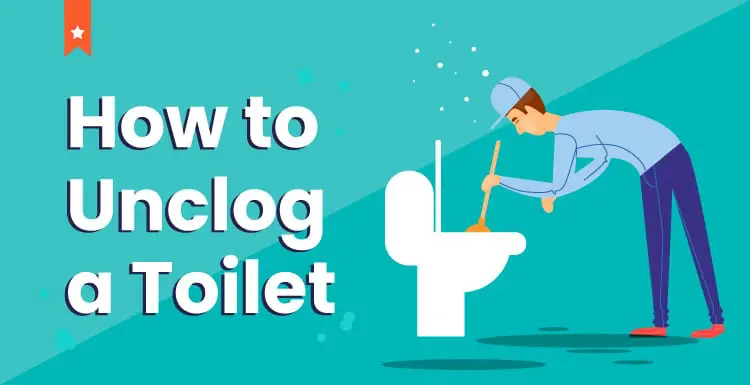Wondering how to unclog a toilet?
If so, you’re in the right place. Our complete guide covers both natural remedies and what the pros do. Read on to learn all you need to know.
Wondering How to Unclog a Toilet?
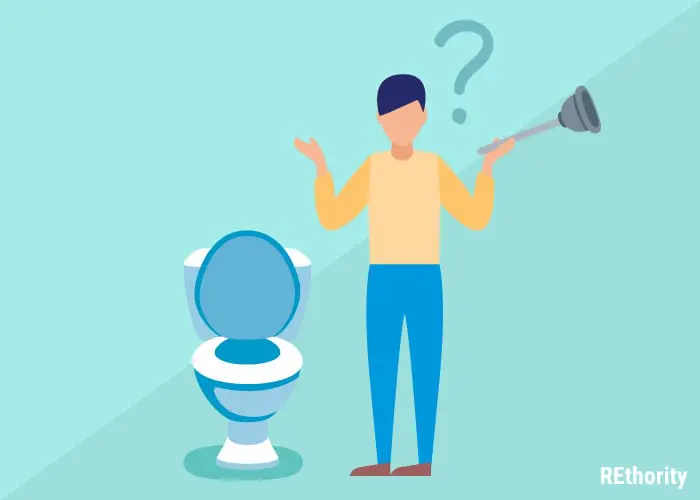
Find out how to unclog a toilet with or without a plunger in this guide. There are many effective methods you can use for unclogging a toilet.
Using anything from unexpected household items to a dose of hot water, you can dislodge nearly any toilet clog within a few minutes!
Of all the things that can go wrong in a house, a clogged toilet ranks as one of the most frustrating. Fortunately for you, however, you don’t have to deal with this pesky issue for long. You can bust the clog fast if you know what to use!
We’re sharing how to unclog a toilet in multiple ways. If the trusty plunger doesn’t work, or if you just don’t have one handy, we’ve got a few genius methods that will really move things along.
These methods are not always pleasant, but the results are worth it. You’ll get step-by-step instructions on how to unclog a toilet using:
- A plunger
- No plunger at all
- Hot water
- Dish soap
- Baking soda and vinegar
- A coat hanger
- A toilet snake
The best method is always the one that works the fastest. It also helps to have the items/tools on hand. Scroll down to find the method that will work best for you.
How to Unclog a Toilet with a Plunger
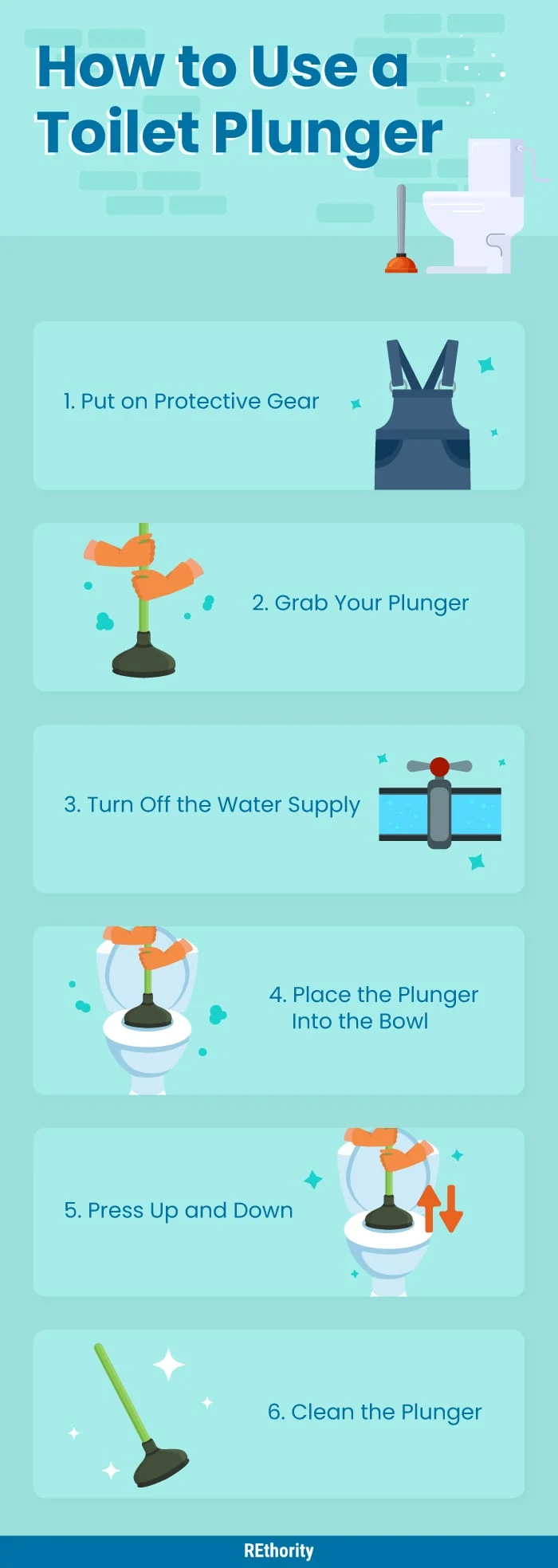
Sure, a plunger is the first thing you think of to unclog a toilet. But are you using the toilet plunger correctly?
Most people don’t angle the plunger the right way, use the appropriate motion, or place it correctly to dislodge the clog.
Here’s how to unclog a toilet with a plunger the right way:
- Put on protective gear. We recommend gloves, goggles, and a mask to prevent water and waste particles from hitting your face and hands as you plunge.
- Grab your plunger. A standard plunger has an orange cup shaped like a bowl. A toilet plunger has a black cup with an extra flange inside the cup to fit into the toilet drain. Either one will work, but you’ll have to use more force to create a good seal with a standard plunger.
- Open the tank at the back of your toilet and look for the flapper valve (connected by a small chain to the flushing handle). Make sure it’s closed, and wait a few minutes. Turn off the water supply with the valve behind your toilet. This will keep it from overflowing.
- Place the plunger in the toilet bowl. Make sure the water covers the plunger cup. If it doesn’t, add water to the bowl so the toilet is about half full (let’s be optimistic here).
- If using a toilet plunger, place the inner flange into the toilet drain opening. Make sure the cup is covered with water as you lower it down to form a good seal.
- Press firmly (but slowly to avoid backsplash) downward, then pull the plunger handle upward. Push down and pull up a few times to force air into the toilet drain pipe. This moves the clog and allows your toilet bowl to flush.
- Clean the plunger after use by soaking it in bleach and water or a similar disinfecting cleaning solution. Store it safely, and dispose of your protective gear.
Usually, a plunger is all you need to quickly unclog a toilet. But what if you don’t have a plunger? We’ve got you covered.
How to Unclog a Toilet Without a Plunger
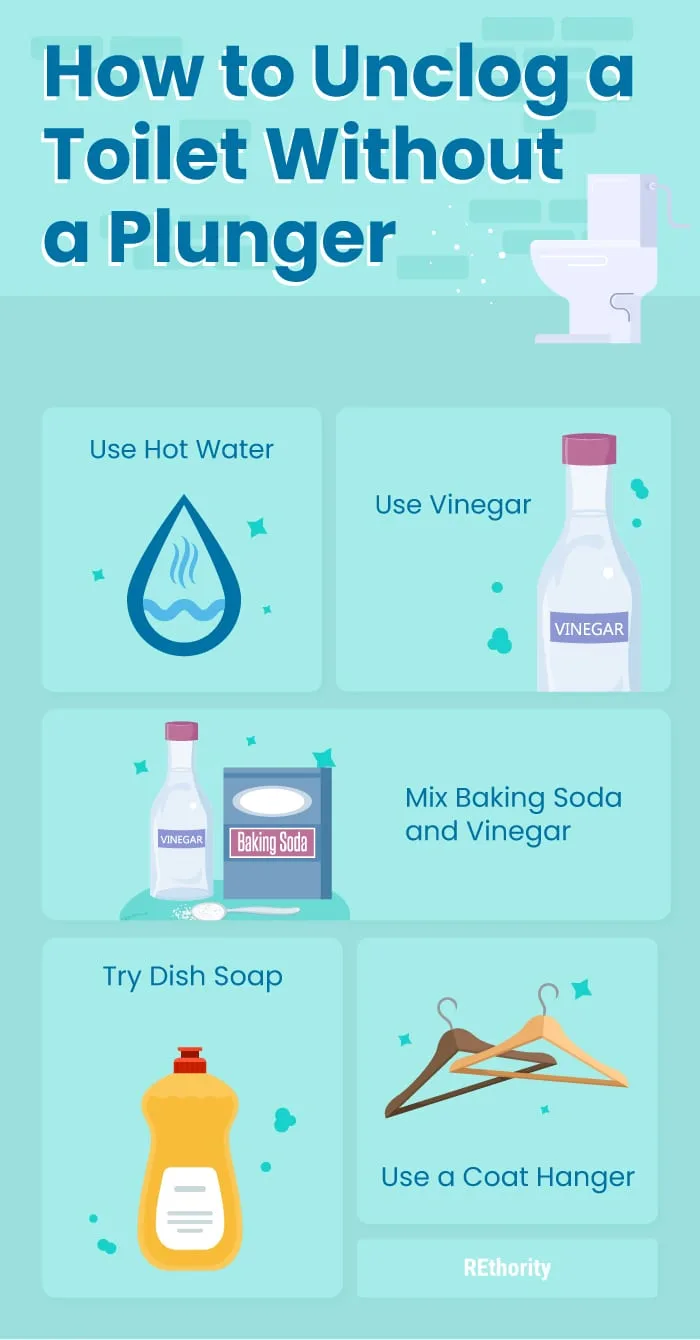
Unclogging a toilet without a plunger is a little less straightforward, but make no mistake—it can be done with a little creativity!
You can make use of a few common household items to unclog a toilet without a plunger. Here are the most effective methods when you find yourself plunger-less.
How to Unclog a Toilet with Hot Water
You can use hot water to unclog a toilet in a pinch. The heat helps bust up any clogs that are keeping your toilet from flushing. The hotter, the better, but don’t use boiling water for this method.
- Fill a container with very hot water. If your tap water doesn’t get hot enough, use a pan and heat some water on the stove.
- Pour the hot (not boiling) water into the toilet bowl, angled toward the drain. Allow it to sit for a few minutes to work on breaking up the clog.
- You might see the water start to drain on its own after a minute or two. If so, flush again to remove any traces left of the clog. If you don’t see the water drain, jump to the next section: Unclogging a Toilet with Dish soap.
How to Unclog a Toilet with Dish Soap
Hot water is often enough to do the trick, but adding dish soap to the method makes it even more effective. Unclogging a toilet with dish soap and hot water is easy and only takes a few minutes.
- Squirt at least 1/4 cup of dish soap into the toilet bowl and allow it to sit for about 10 minutes. You want to give it time to move down the bowl and into the drain.
- While the dish soap sits, fill a container with very hot water. If your tap water doesn’t get very hot, heat some water in a pan on the stove until it is very hot but not boiling.
- Pour the hot water into the toilet bowl, angled toward the drain. Allow the hot water to sit for a few minutes to continue working on the clog.
- Watch to see if the water drains on its own. The dish soap may be enough to help move the clog along, but if not, try the next method: unclogging a toilet with baking soda and vinegar.
How to Unclog a Toilet with Baking Soda and Vinegar
Baking soda and vinegar aren’t just for science projects. They happen to be an effective duo to unclog a toilet! Basically, this method works by fizzing and bubbling away the wretched clog.
- Sprinkle about 1 cup of baking soda into the toilet bowl, aiming for the drain. Pour 1 cup of white vinegar into the toilet bowl and stand back.
- The baking soda/vinegar mixture will bubble and fizz for a few minutes. Allow them to sit for about 30 minutes to allow the mixture to dislodge the clog.
- Heat some water (hot but not boiling) in a pan or from the tap. Pour it down into the toilet bowl and watch to see if it drains. Flush once more to finish dislodging the clog if it drains.
- If this method doesn’t work the first time, it’s worth trying again. The baking soda/vinegar mixture is powerful, but it can take more than one try to bust up a serious clog.
- If two tries still won’t unclog it, it’s time to try the next method: Unclogging a toilet with a hanger.
How to Unclog a Toilet with a Hanger
You’ve heard of toilet augers or plumbing snakes, but the chances that you have one in your home right now are pretty slim. The next best thing to try is a homemade toilet auger or snake using a coat hanger.
Warning: You’ll have to get a little closer to the toilet to try this method. Use gloves, goggles, and a mask if possible to protect your face and hands. A metal coat hanger can damage your toilet, so only use this method if you’re desperate and don’t have time to get an auger.
- Locate a wire coat hanger and unwind the twisted portion. Bend the triangular part into a straight line, but leave the hook curved.
- Wrap an old rag around the hook and secure it with duct tape. This will help keep it from scratching your toilet or damaging your pipes.
- With your protective gear on, angle the wire hanger down into the toilet drain and gently move it forward until you feel resistance from the clog. Gently push into the clog and move the hanger around until the water begins to drain.
- Flush the toilet once or twice afterward to fully clear the clog. Safely dispose of the rag-wrapped hanger and protective gear. Buy a toilet auger so you’ll be more prepared next time there’s a clog!
How to Unclog a Toilet with a Toilet Snake
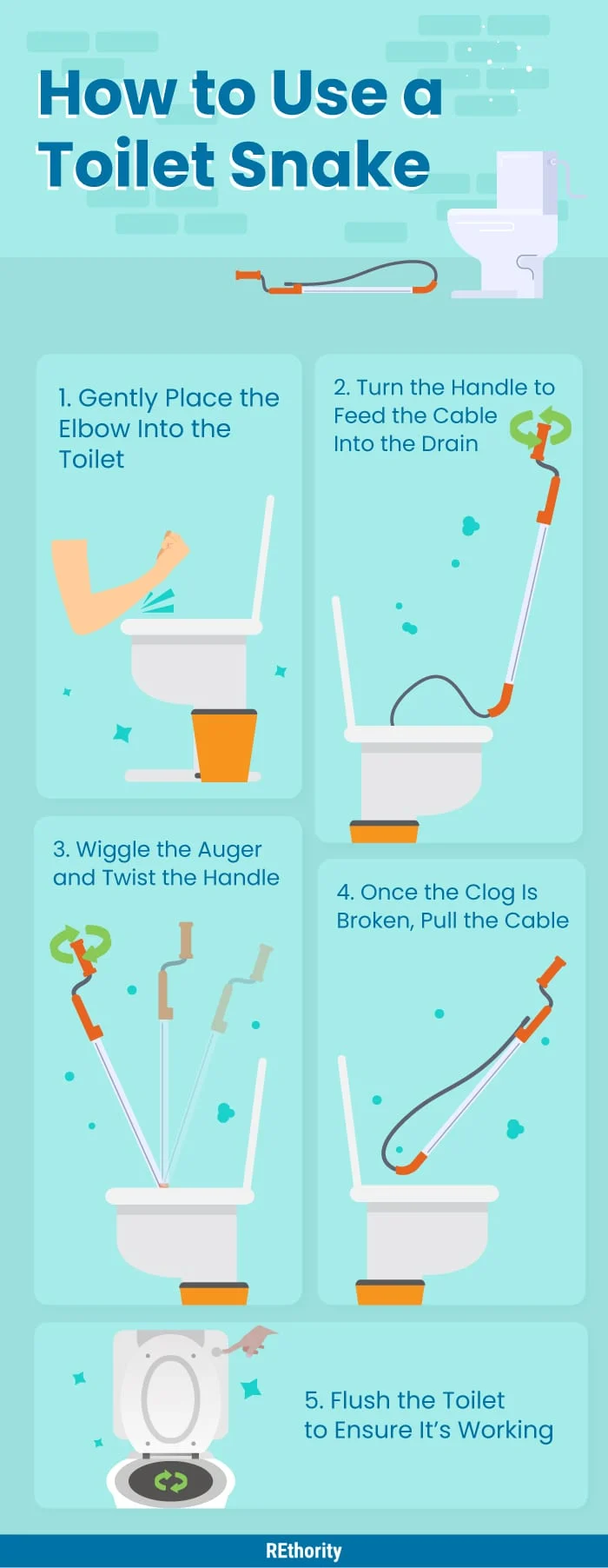
Most people call it a snake, but it’s referred to as a toilet auger in the plumbing community. These are small tools that are maneuvered into plumbing pipes to dislodge and destroy clogs.
They’re usually made up of a hollow tube shaft that protects your toilet from the flexible metal cable inside. They have a crank handle at the top. Using a toilet auger or plumbing snake might seem complicated, but it’s not.
Here’s how to use a toilet auger to unclog a toilet. We recommend wearing protective gloves while using a toilet auger.
- Place the bent rubber “elbow” end of the auger into the toilet and gently place it into the drain.
- Start slowly turning the crank handle to begin feeding the auger cable into the toilet’s u-curve or s-curve beyond the drain opening. Don’t rush it, or the cable will coil back and tangle itself.
- Try to crank the handle slowly until the auger has fed all of the cable out into the toilet drain pipe. The metal tube will “disappear” into the rubber casing to let you know the cable is completely out.
- If you feel resistance along the way, you’ve likely found the clog. Don’t push harder or crank more just yet. Instead, wiggle the auger and crank the handle backward a bit to get it moving. Because of the spiral tip at the end of the auger, your goal is to get it wound and tangled up in the clog enough to move it.
- As you move the auger around and crank the handle forward and backward, you’ll start to feel less resistance as the clog breaks up. Keep working until the water in the toilet bowl drains away.
- Once the water has drained out and clog is disintegrated, pull the cable out by pulling the auger handle backward to expose it. Warning: It will have waste and toilet debris on it, so keep those gloves on.
- Place the auger on some old newspapers nearby until you can clean it up. Flush the toilet to make sure it drains properly. If it doesn’t, just repeat the process with the auger to fully clear the clog.
How to Clean a Toilet Auger
Once you’ve sent your toilet auger deep into the plumbing of your toilet, you’ll want to give it a good cleaning. Fortunately, it’s simple to clean these tools.
Fill a bucket with dish soap or detergent and disinfectant (such as bleach), or use vinegar and hot water. Soak the auger in the bucket for about 5 minutes.
Then, use a clean toilet brush to scrub away the debris remaining on the cable and tip. Afterward, rinse the auger off with hot water and dry it with an old cloth or clean newspaper. Do not put it away without drying it fully, or it will rust.
When to Call a Plumber to Unclog a Toilet
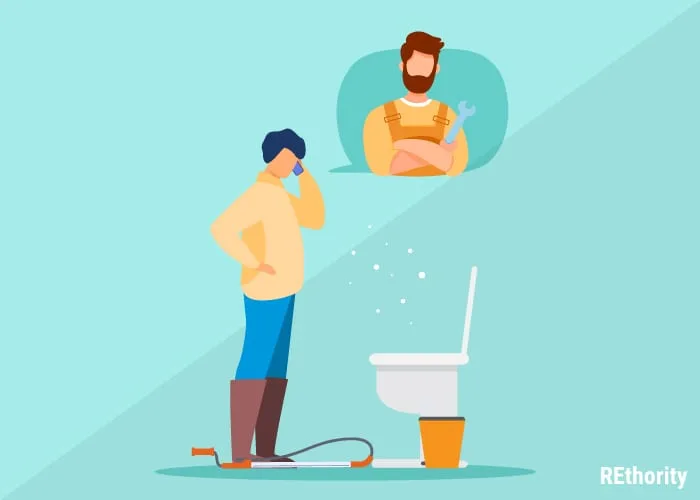
Unclogging a toilet on your own isn’t always effective. Some clogs can be located deep in your plumbing and may be impossible to reach or disintegrate with DIY methods.
Clogs may also be made up of hard-to-dislodge items. In any of these cases, you’ll need to call a plumber.
Call a plumber to unclog your toilet if:
- You’ve tried everything with no luck: It’s a good idea to try and dislodge the clog on your own first, but if the initial DIY methods don’t budge the clog, you’ll need to call a plumber.
- A foreign object was flushed: Whether it’s a toy, comb, toothbrush, or remote (yep, it’s happened), foreign objects get accidentally flushed all the time. Don’t try any DIY unclogging methods if this is the case, or if you think it might be. A plumber can safely remove the object without damaging your toilet or plumbing.
- You think the sewage line could be clogged: If the clog seems to be in the sewer and not your toilet drain or plumbing, you’ll need a professional’s help to fix the issue. There could be a break in the sewer line, and this requires immediate attention.
- The toilet has overflowed or looks like it is about to: No one wants wastewater gushing out of the toilet into the bathroom. If your toilet has overflowed or looks like it’s on the verge, just call a plumber to come out right away. They’ll be able to fix the problem quickly.
- The toilet supply line is frozen: A water pipe that has frozen will stop your toilet from filling and flushing, and DIY methods can cause more damage. Frozen pipes can burst, so always opt for a professional if frozen pipes prevent you from flushing.
Unclogging a toilet is no walk in the park, but plumbers have ample experience dealing with every type of clog you can imagine. It’s fine to try a few basic methods to unclog your toilet.
But in the end, only a plumber’s expertise can ensure the clog is completely gone and won’t come back with a vengeance in a day or two. They can also identify if a deeper issue is causing your toilet to clog.
Whether you’re fully equipped with a toilet plunger and auger or just trying to make due with a coat hanger and some baking soda, unclogging a toilet isn’t impossible or anything to panic about.
As long as you’re careful and know when to pass the baton to a professional, it’s a good idea to learn how to unclog a toilet on your own.
Consider it essential knowledge that everyone should have – and it might just save your bathroom from a terrible overflow incident!

